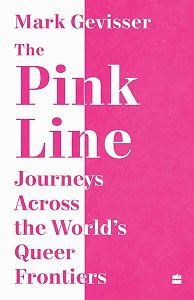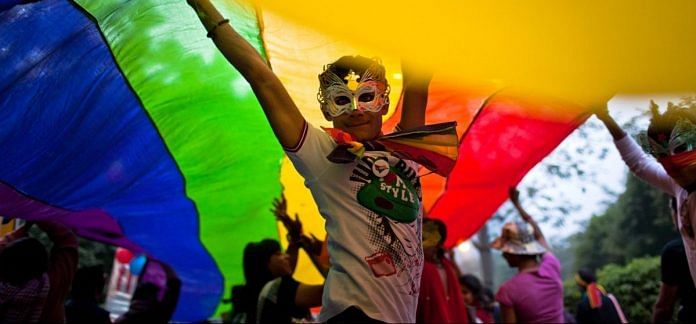After the U.S. Supreme Court ruling mandating marriage equality across the United States on June 26, 2015, President Barack Obama gave the instruction that the White House be bathed in the colors of the rainbow flag, and spoke of how, through “the countless small acts of courage of millions of people across decades … an entire country” had come to “realize that love is love.”
Love was also money.
Visa put out an ad with the tag “Love. Accepted Everywhere,” and Jell-O ran the slogan “JELL-O-V-E is for everyone” beneath wobbly cubes the colors of the rainbow.17 And while high-end liquor brands like Absolut had long courted a gay market, even the more downmarket beer brands started draping themselves in the rainbow flag: Budweiser introduced a special-edition bottle with the Statue of Liberty imposed over the rainbow flag. At least fifty major American corporations dipped their brands into rainbow colors. These included Coca-Cola, AT&T, YouTube, Levi’s, Mastercard, MTV, Gap, and American Airlines.
The previous year, to protest Russia’s anti-homosexual laws, Google had done a rainbow doodle on the day the Winter Olympics opened at Sochi. Nike, Adidas, and Converse competed with special rainbow editions of their sneakers. In 2012, Target, an American retailer that had drawn criticism for funding conservative anti-gay politicians, joined the marriage equality campaign with a new ad for its wedding registry, in which two smiling men held hands above the words, “Be yourself, together.”
Also read: New Delhi’s latest LGBTQ+ job fair proves career and identity don’t have to remain separate
That year’s June World Pride in London was dominated by corporate phalanxes competing with one another for the cleverest gay-themed corporate branding, and some even used the opportunity to do direct marketing: British Airways handed out a “Pride Special” offer of a 20 percent discount on your next flight. A few months later, in India, I watched employees from three American multinational corporations with hubs in the city—Google, Hewlett Packard, and Goldman Sachs—join the hijras and the queer activists at Bangalore Pride. Google’s “Gayglers,” the company’s in-house LGBT affinity group, stole the show with their cute same-sex android couples holding hands and waving rainbow flags.
Two decades before, in the 1990s, some scholars and activists had begun predicting what Bob Cant called “McPink” : “a global pink economy which promotes a series of ever-changing lifestyle options,” rather than a battle for rights and freedom. Was consumerism the new battleground in the rights battle, or had it overwhelmed the struggle and turned it into a brand?
As in the case of Carnival cruise lines and Bermuda or the boycotts of the sultan of Brunei’s luxury hotels, the ever-growing pink market was one motivation for many multinational corporations to embrace LGBT rights as one of their core “values.” The other was the changing legal position of their own workforces. North American and European companies were incorporated in countries where labor legislation now expressly forbade discrimination on the basis of sexual orientation and gender identity, and this influenced corporate policy, particularly when it came to partner rights. Some corporations went further, setting out specifically to make LGBT-friendly work environments so as to attract queer staff. As the Goldman Sachs branding at Bangalore Pride in 2012 declared: “Inclusion Shapes Our Culture.”
While in Bangalore, I met a Google account strategist named Yash Godbole, who told me how, after he had signed on anonymously to the company’s global Gayglers listserv, a human resources manager “joined the dots” and contacted him to ask him if he would like to set up an India chapter. To help him make up his mind, his employers sent him to Sydney Mardi Gras so that “I could see what happens elsewhere, and how people around the world behave around these issues.” With the encouragement of his bosses, Godbole first came out to his colleagues, and then to his family: the fact that he was accepted at work made “all the difference” at home, he told me.
But if “diversity and inclusivity” was a labor recruitment strategy, it was also a mode of corporate branding, suggesting the kind of trendsetting forward motion—the essence of modernity—that these particular brands sought to project. As a Heineken campaign launched as early as 2011 put it: “Open your world.”
Open bottles, open societies, open closets. From Heineken to Google to George Soros to the ideological descendants of Harvey Milk (“Gay brothers and sisters, you must come out!”), the people who sent these messages out spoke to a particular way—a primarily American way—of being gay or LGBT in the world. In almost every country I visited doing this research, I met some young person who called him or herself Beyonceì. And I saw rainbow flags and stickers in rural Indian villages and slick Mexico City apartments, in Soviet-era tower blocks in provincial Russian cities and in refugee doss-houses on the outskirts of Nairobi.
By 2017, Grindr, the gay geolocation hookup app, had twenty- seven million users in 192 countries. I heard, from users in repressive Egypt or Nigeria or the Palestinian West Bank, how the app had been not only a safer way to help them find people in the same district or even on the same street, but had also spun them out into a broader, boundaryless world where their nationalities were just one way of defining themselves: they could also identify themselves by signing on to one or more of Grindr’s twelve “tribes”: Bear, Clean-cut, Daddy, Discreet, Geek, Jock, Leather, Otter, Poz (HIV-positive), Rugged, Trans, and Twink.
But by 2018, Grindr—founded by an American Israeli in New York—was fully owned by a Chinese gaming company based in Beijing, although it was not yet available in most Chinese cities: here Blued prevailed, with its forty million users. The American-inflected “global gay” language was thus no longer only funded by Western capital flows, but it had profoundly different meanings, depending on where it was spoken. The global language of “gay” was appropriated, and indigenized, too.
Also read: LGBT+ inclusive economies are likely to recover better from Covid-crisis
In India, the hookup site PlanetRomeo—originally German, now run out of Amsterdam—was the primary online mode of communication for homosexual and bisexual men in the country, used not only to hook up, but also to promote gay products and parties, and to find other queer people nearby. In his 2011 doctoral study of the app in India, Akhil Katyal describes the way it “sets the stage for the idiom of a worldwide ‘genuine gay community’ that the [Planet Romeo] team constantly uses in its publicity material, and for the heavily globalized references that frame most of its user profiles. It is not surprising to find photographs of Brad Pitt, Backstreet Boys or Daniel Radcliffe used as profile pictures by people in Raipur or Meerut in India, references to the San Francisco ‘bondage scene’ or the Chilean Pokeìmon subcultures among Kolkata users, or citations from Ghalib and Robert Frost and Timberlake or Sultanpuri jostling with each other in the same profile.”
There might, thus, have been a surface continuity to the images one saw of Pride parades from Manila to Montevideo, or a similar beat to music in gay discos, or even a shared coded language on hookup sites when it came to specifying sexual preference. But in the end these were all surface wrappers, like the rainbow flag itself, furled as it was around various agendas and subjectivities and brands.
Where there was continuity, of course, was in the reason why people wore these wrappers in the first place: a common experience of marginalization, or repression, and the role that the wrapper played as some kind of talisman, as a portent of liberation. There was something in common structurally about the lives of all the Beyonceìs I met, in Nigeria and Egypt and Uganda and the Philippines and India, not least in the violence they had experienced because they were effeminate. Perhaps this is why they had taken on the name of a glorious, resilient Amazon. But they shared almost nothing culturally, because of their different family structures and religious faiths, their different classes and national or ethnic cultures.
Also read: No women, LGBT representation — criminal law review panel criticised for lack of diversity
As with the Beyonceìs at one end of the social scale, so, too, with the Gayglers at the other. On the surface the Google staffers I saw marching at Bangalore Pride in 2012 looked just the same as those at World Pride London or the Sydney Mardi Gras, dressed as they all were in their cute gay android T-shirts. But the Indian Gayglers were different in one dramatic way: except for Yash Godbole himself, not one of them was openly gay. The rest—about 150 in total—were “allies,” associating with the group because it was hip and a sign of modernity.
The non-gay Gayglers were “giving cover to those people who cannot yet risk being seen on the streets,” Yash Godbole told me. Google might have a global diversity and inclusivity policy, but “of course it gets diluted in countries where it’s still against the law, and where there’s still a lot of taboo in society.”

This excerpt from The Pink Line: Journeys Across the World’s Queer Frontiers has been published with special permission from Harper Collins.



